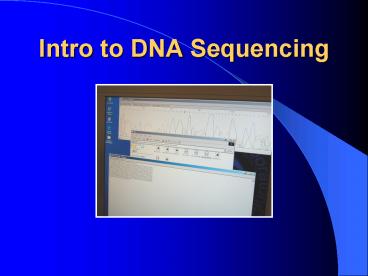Intro to DNA Sequencing - PowerPoint PPT Presentation
1 / 22
Title:
Intro to DNA Sequencing
Description:
Determine the sequence of nucleotide bases in a ... Honey bee. 2 puffer fish. 2 fruit flies. 2 sea squirts. 2 roundworms. Baker's yeast. Escherichia coli ... – PowerPoint PPT presentation
Number of Views:31
Avg rating:3.0/5.0
Title: Intro to DNA Sequencing
1
Intro to DNA Sequencing
2
Definition
- A technique used to determine the sequence of
nucleotide bases in a DNA molecule or fragment
3
Quick Quiz
- DNA sequencing is used to
- Determine the sequence of nucleotide bases in a
molecular project - Determine the order of genes in a chromosome
- Determine whether or not PCR was successful
- Determine whether or not DNA purification was
successful
4
Application Examples
- DNA sequencing is commonly used to
- Identify useful regions of DNA for other
applications - Identify nucleotides in a gene and the inferred
protein sequence - Generate data for taxonomic analysis
- Identify gene defects associated with certain
diseases - Analyze whole genomes
5
Non-examples
- DNA sequencing is NOT commonly used for
- DNA fingerprinting
- Making monoclonal antibodies
- Conducting stem cell research
6
Quick Quiz
- Which of the following is NOT an application of
DNA sequencing? - Generate taxonomic data to determine evolutionary
relationships - Mapping Genomes
- Confirming the presence of a particular gene in
an environmental sample - DNA fingerprinting
7
Technique 1 Maxam-Gilbert (chemical cleavage)
- A pool of identical DNA fragments is labeled at
one end and split into four tubes - The fragments are broken preferentially at one of
the four nucleotides, under conditions where only
an average of about one break is made per
fragment - The 4 reactions are denatured and run out on an
acrylamide sequencing gel
8
http//www.cbs.dtu.dk/staff/dave/roanoke/genetics9
80211.html
9
Technique 2 Sanger (dideoxy sequencing)
- The reaction is split into 4 tubes, each
containing - Template DNA, primer, DNA polymerase, dNTPs (A,
T, G, C), and a low concentration of one
dideoxynucleotide (ddA, ddT, ddG, or ddC) - Template DNA is denatured, a primer anneals, and
a complementary DNA strand is extended by DNA
polymerase - Once incorporated, a ddNTP will block further DNA
extension - This results in each reaction tube containing a
mixture of DNA strands of many different lengths - The 4 reactions are denatured and run in separate
lanes of an acrylamide sequencing gel
10
Sanger Sequencing
11
Technique 3 Dye-terminator sequencing
- Combines the Sanger method (chain termination)
with PCR - ddNTPs are fluorescently labeled so each one has
a unique chromaphore - Gel is read by a sequencer, which translates the
DNA bands into a 4-color chromatogram
12
Dye-Termination Sequencing
http//oregonstate.edu/instruction/bb492/figletter
s/FigG4.html
http//www.igh.cnrs.fr/equip/sequence/DNASEQCENTER
.html
13
Dye-terminator sequencing
14
Quick Quiz
- In Dye-Terminator sequencing, each ddNTP is
labeled with a unique _________ tag. - Bioluminescent
- Radioactive
- Fluorescent
- Intercalated
15
Timeline for Human Genome Project
16
Whole Genome Sequencing
- Examples of those sequenced by 2007
- Human
- Sea urchin
- Chimpanzee
- Mouse
- Rat
- Honey bee
- 2 puffer fish
- 2 fruit flies
- 2 sea squirts
- 2 roundworms
- Baker's yeast
- Escherichia coli
- More recently
- Horse
- Pig
- Chicken
- Dog
- Rhesus macaque monkey
- Over 300 sequenced to date - many are bacteria
17
- END
18
Resources
- http//www.dnai.org/text/mediashowcase/index2.html
?id608 - http//www.dnalc.org/ddnalc/resources/cycseq.html
19
California State Chemistry Standards
- Grade 8
- 5a. Reactant atoms and molecules interact to
form products with different chemical properties - 6c. Living organisms have many different kinds
of moleculesincluding DNA - Grades 9-12
- 2. Biological, chemical and physical properties
of matter result from the ability of atoms to
form bonds from electrostatic forces - 6. Solutions are homogenous mixtures of two or
more substances - 8. Chemical reaction rates depend on factors
that influence the frequency of collision of
reactant molecules
20
California State Biology Standards
- Grade 7
- 2e. DNA is the genetic material of living
organisms and is located in the chromosomes of
each cell - 3a. Genetic variation and environmental factors
are causes of evolution and diversity of
organisms - Grades 9-12
- 1. Fundamental life processes of plants and
animals depend on a variety of chemical reactions
that occur in specialized areas of the cell - 2. Mutation and sexual reproduction lead to
genetic variation in a population - 4. Genes are a set of instructions encoded in
the DNA sequence of each organism - 5. Genetic composition of cells can be altered
by incorporation of exogenous DNA into the cells
21
California State Investigation and
ExperimentationStandards
- Grades 7
- b. Select and use appropriate tools and
technology - Grade 8
- a. Plan and conduct a scientific investigation
to test a hypothesis - Grades 9-12
- a. Select and use appropriate tools and
technology to perform tests, collect data,
analyze relationships, and display data - b. Identify and communicate sources of
unavoidable experimental error - c. Identify possible reasons for inconsistent
results - d. Formulate explanations by using logic and
evidence - k. Recognize the cumulative nature of scientific
evidence
22
National Standards
- Grades 6-12
- Content Standard A Science as Inquiry
- Content Standard C Life Science
- Content Standard E Science and Technology































